Prediction of Spatiotemporal Changes in Sloping Cropland in the Middle Reaches of the Yangtze River Region under Different Scenarios
Abstract
:1. Introduction
2. Study Area
3. Materials and Methods
3.1. Data Sources and Preconditioning
3.2. Methods
3.2.1. PLUS-Based LUCC Simulation
3.2.2. SSP-RCP-Based Scenario Simulation
3.2.3. Construction of a Cropland Slope Spectrum
4. Results
4.1. Simulation and Model Accuracy
4.2. Variation Characteristics of Sloping Cropland during 2000–2020
4.2.1. Distribution Characteristics of Sloping Cropland
4.2.2. Changing Characteristics of Sloping Cropland
4.3. Predictions of Sloping Cropland Based on Different Scenarios
4.4. Predictions of Cropland Slope Spectrum and ACCI
4.5. Variations from the Perspective of Spatial Dimensions
4.5.1. Sloping Cropland Changes and Trends in Hubei Province
4.5.2. Sloping Cropland Changes and Trends in Hunan Province
4.5.3. Sloping Cropland Changes and Trends in Jiangxi Province
4.6. Drivers of Sloping Cropland Change
5. Discussion
6. Conclusions
- (1)
- The areas of cropland and sloping cropland in the MRYRR both showed an overall downward trend in 2000–2020, whereas the proportion of sloping cropland presented an overall upward trend. It is expected that by 2035, the cropland area will exhibit various changing trends under different scenarios. The increase will be largest under the SSP4-3.4 scenario, while the decrease will be largest under the SSP3-7.0 projection. If the current trend continues (SSP2-4.5), the area of cropland will continue to decline.
- (2)
- The average slope of cultivated land in the MRYRR gradually increased by 0.33° in 2000–2020 and is expected to further increase until 2035. The highest average slope of cropland occurred under the SSP4-3.4 scenario and the lowest occurred under the SSP4-6.0 scenario. At the provincial level, in 2035, the average slope of cultivated land will be the highest in Hunan Province and the lowest in Jiangxi Province, with a moderate value for Hubei Province.
- (3)
- According to the ACCI values in different periods, the cropland in the MRYRR will maintain a climbing development in 2020–2035. The intensity of cropland climbing will be highest under the SSP4-3.4 scenario both for the entire region and the three provinces, exceeding that in 2005–2010.
- (4)
- Among the 14 drivers selected, the average annual precipitation and GDP contributed the most to the expansion of sloping cropland. Under the trend of climate warming and the control of the arable land balancing policy, rich rainfall and a high level of economic development will drive the cropland in plains to the slopes. The flow-out of sloping cropland is greatly affected by human activities. The findings of this study can provide new insights with strong data support for decision-making in the rational utilization of cultivated land, in addition to soil and water conservation.
Author Contributions
Funding
Institutional Review Board Statement
Informed Consent Statement
Data Availability Statement
Conflicts of Interest
References
- Xu, D.; Yang, F.; Yu, L.; Zhou, Y.; Li, H.; Ma, J.; Huang, J.; Wei, J.; Xu, Y.; Zhang, C.; et al. Quantization of the coupling mechanism between eco-environmental quality and urbanization from multisource remote sensing data. J. Clean. Prod. 2021, 321, 128948. [Google Scholar] [CrossRef]
- Wang, M.; Kroeze, C.; Strokal, M.; Vliet, M.T.H.; Ma, L. Global Change Can Make Coastal Eutrophication Control in China More Difficult. Earth’s Future 2020, 8, e2019EF001280. [Google Scholar] [CrossRef]
- Song, W.; Han, Z.; Deng, X. Changes in productivity, efficiency and technology of China’s crop production under rural restructuring. J. Rural Stud. 2016, 47, 563–576. [Google Scholar] [CrossRef]
- Xie, H.; Zhang, Y.; Choi, Y. Measuring the Cultivated Land Use Efficiency of the Main Grain-Producing Areas in China under the Constraints of Carbon Emissions and Agricultural Nonpoint Source Pollution. Sustainability 2018, 10, 1932. [Google Scholar] [CrossRef] [Green Version]
- Zhou, Y.; Li, X.; Liu, Y. Cultivated land protection and rational use in China. Land Use Policy 2021, 106, 105454. [Google Scholar] [CrossRef]
- Deng, X.; Huang, J.; Rozelle, S.; Zhang, J.; Li, Z. Impact of urbanization on cultivated land changes in China. Land Use Policy 2015, 45, 1–7. [Google Scholar] [CrossRef]
- Liu, Y.; Zhou, Y. Reflections on China’s food security and land use policy under rapid urbanization. Land Use Policy 2021, 109, 105699. [Google Scholar] [CrossRef]
- Wu, Y.; Shan, L.; Guo, Z.; Peng, Y. Cultivated land protection policies in China facing 2030: Dynamic balance system versus basic farmland zoning. Habitat. Int. 2017, 69, 126–138. [Google Scholar] [CrossRef]
- Chen, W.; Zhao, H.; Li, J.; Zhu, L.; Wang, Z.; Zeng, J. Land use transitions and the associated impacts on ecosystem services in the Middle Reaches of the Yangtze River Economic Belt in China based on the geo-informatic Tupu method. Sci. Total Environ. 2020, 701, 134690. [Google Scholar] [CrossRef]
- Xiao, M.; Zhang, Q.; Qu, L.; Hussain, H.; Dong, Y.; Zheng, L. Spatiotemporal Changes and the Driving Forces of Sloping Farmland Areas in the Sichuan Region. Sustainability 2019, 11, 906. [Google Scholar] [CrossRef]
- Yu, H.; Zeng, S.; Wang, Q.; Dai, J.; Bian, Z.; Chen, F. Forecast on China’s cultivated land protection baseline in the new era by multi-scenario simulations. Res. Sci. 2021, 43, 1222–1233, (In Chinese with English abstract). [Google Scholar]
- Shuang, W.; Xiaojie, F.; Yongdong, W.; Zicheng, Z.; Tingxuan, L.; Shuqin, H.; Xizhou, Z.; Haiying, Y.; Huagang, H.; Tao, L.; et al. Characteristics of nitrogen loss in sloping farmland with purple soil in southwestern China during maize (Zea mays L.) growth stages. Catena 2019, 182, 104169. [Google Scholar]
- Ying, L.; Shunbo, Y. Impact of the Sloping Land Conversion Program on rural household income: An integrated estimation. Land Use Policy 2014, 40, 56–63. [Google Scholar]
- Wang, F.; Liang, W.; Fu, B.; Jin, Z.; Yan, N. Spatial and temporal changes of cultivated land and quantitative analysis of ration safe cultivated land on the Loess Plateau in recent years. Arid. Land Geogr. 2020, 43, 161–171, (In Chinese with English abstract). [Google Scholar]
- Lizhi, J.; Wenwu, Z.; Bojie, F.; Stefani, D.; Shuai, W.; Yanxu, L.; Ruijie, Z. Effects of minimum soil disturbance practices on controlling water erosion in China’s slope farmland: A meta-analysis. Land Degrad. Dev. 2019, 30, 706–716. [Google Scholar]
- Mei, Q.; Guangzhe, L.; Yin, L.; Erika, D.; Zsuzsanna, P.; Xiaoqian, X.; Yang, C. Experts’perceptions of the sloping land conversion program in the Loess Plateau, China. Land Use Policy 2017, 69, 706–716. [Google Scholar]
- Jintao, X.; Ran, T.; Zhigang, X.; Michael, T.B. China’s Sloping Land Conversion Program: Does Expansion Equal Success? Land Econ. 2010, 86, 219–244. [Google Scholar]
- Zhen, L.; Qiuming, L.; Jing, L.; Assem, A.H. Does participation in the sloping land conversion program reduce the sensitivity of Chinese farmers to climate change? Land Use Policy 2020, 99, 105021. [Google Scholar]
- Borrelli, P.; Robinson, D.A.; Panagos, P.; Lugato, E.; Yang, J.E.; Alewell, C.; Wuepper, D.; Montanarella, L.; Ballabio, C. Land use and climate change impacts on global soil erosion by water (2015–2070). Proc. Natl. Acad. Sci. USA 2020, 117, 21994–22001. [Google Scholar] [CrossRef]
- Chen, Z.; Shi, D.; He, W.; Xia, J.; Jin, H.; Lou, Y. Spatio-temporal distribution and evolution characteristics of slope farmland resources in Yunnan from 1980 to 2015. Trans. CSAE 2019, 35, 256–265, (In Chinese with English abstract). [Google Scholar]
- Ding, W.B.; Jiang, G.Y.; Shi, D.M.; Liu, Y.J.; Jiang, P.; Chang, S.G.; Liu, Z.P. Effect of different soil properties on plow-layer soil quality of sloping farmland in purple hilly areas. Acta Ecol. Sin. 2017, 37, 6480–6493, (In Chinese with English abstract). [Google Scholar]
- Yu, D.; Hu, S.; Tong, L.; Xia, C. Spatiotemporal Dynamics of Cultivated Land and Its Influences on Grain Production Potential in Hunan Province, China. Land 2020, 9, 510. [Google Scholar] [CrossRef]
- Ge, D.; Long, H.; Zhang, Y.; Ma, L.; Li, T. Farmland transition and its influences on grain production in China. Land Use Policy 2018, 70, 94–105. [Google Scholar] [CrossRef]
- Min, M.; Miao, C.; Duan, X.; Yan, W. Formation mechanisms and general characteristics of cultivated land use patterns in the Chaohu Lake Basin, China. Land Use Policy 2022, 117, 106093. [Google Scholar] [CrossRef]
- Meng, B.; Wang, X.; Zhang, Z.; Huang, P. Spatio-Temporal Pattern and Driving Force Evolution of Cultivated Land Occupied by Urban Expansion in the Chengdu Metropolitan Area. Land 2022, 11, 1458. [Google Scholar] [CrossRef]
- Yang, S.; Bai, Y.; Alatalo, J.M.; Wang, H.; Tong, J.; Liu, G.; Zhang, F.; Chen, J. Spatial–temporal pattern of cultivated land productivity based on net primary productivity and analysis of influencing factors in the Songhua River basin. Land Degrad. Dev. 2022, 33, 1917–1932. [Google Scholar] [CrossRef]
- Chen, L.; Zhao, H.; Song, G.; Liu, Y. Optimization of cultivated land pattern for achieving cultivated land system security: A case study in Heilongjiang Province, China. Land Use Policy 2021, 108, 105589. [Google Scholar] [CrossRef]
- Pan, L.; Xia, H.; Yang, J.; Niu, W.; Wang, R.; Song, H.; Guo, Y.; Qin, Y. Mapping cropping intensity in Huaihe basin using phenology algorithm, all Sentinel-2 and Landsat images in Google Earth Engine. Int. J. Appl. Earth Obs. 2021, 102, 102376. [Google Scholar] [CrossRef]
- Duan, D.; Sun, X.; Liang, S.; Sun, J.; Fan, L.; Chen, H.; Xia, L.; Zhao, F.; Yang, W.; Yang, P. Spatiotemporal Patterns of Cultivated Land Quality Integrated with Multi-Source Remote Sensing: A Case Study of Guangzhou, China. Remote Sens. 2022, 14, 1250. [Google Scholar] [CrossRef]
- Cao, W.; Zhou, W.; Wu, T.; Wang, X.; Xu, J. Spatial-temporal characteristics of cultivated land use eco-efficiency under carbon constraints and its relationship with landscape pattern dynamics. Ecol. Indic. 2022, 141, 109140. [Google Scholar] [CrossRef]
- Jin, H.; Shi, D.; Lou, Y.B.; Zhang, J.; Ye, Q.; Jiang, N. Evaluation of the quality of cultivated-layer soil based on different degrees of erosion in sloping farmland with purple soil in China. Catena 2021, 198, 105048. [Google Scholar] [CrossRef]
- He, S.; Liang, Z.; Han, R.; Wang, Y.; Liu, G. Soil carbon dynamics during grass restoration on abandoned sloping cropland in the hilly area of the Loess Plateau, China. Catena 2016, 137, 679–685. [Google Scholar]
- Pei, Z.; Xiangyu, T.; Peng, Z.; Jialiang, T. Dynamics of water uptake by maize on sloping farmland in a shallow Entisol in Southwest China. Catena 2016, 147, 511–521. [Google Scholar]
- Ma, Y.; Li, Z.; Deng, C.; Yang, J.; Tang, C.; Duan, J.; Zhang, Z.; Liu, Y. Effects of tillage-induced soil surface roughness on the generation of surface–subsurface flow and soil loss in the red soil sloping farmland of southern China. Catena 2022, 213, 106230. [Google Scholar] [CrossRef]
- Xiaopeng, C.; Beibei, Z.; Quanjiu, W.; Wanghai, T.; Henry, L. Nano-biochar reduced soil erosion and nitrate loss in sloping fields on the Loess Plateau of China. Catena 2019, 187, 104346. [Google Scholar]
- Li, Z.; Li, M.; Xia, B. Spatio-temporal dynamics of ecological security pattern of the Pearl River Delta urban agglomeration based on LUCC simulation. Ecol. Indic. 2020, 114, 106319. [Google Scholar] [CrossRef]
- Cunha, E.R.D.; Santos, C.A.G.; Silva, R.M.D.; Bacani, V.M.; Pott, A. Future scenarios based on a CA-Markov land use and land cover simulation model for a tropical humid basin in the Cerrado/Atlantic forest ecotone of Brazil. Land Use Policy 2021, 101, 105141. [Google Scholar] [CrossRef]
- Fan, Z. Simulation of land-cover change in Jing-Jin-Ji region under different scenarios of SSP-RCP. J. Geogr. Sci. 2022, 32, 421–440. [Google Scholar] [CrossRef]
- Cao, M.; Tang, G.A.; Shen, Q.; Wang, Y. A new discovery of transition rules for cellular automata by using cuckoo search algorithm. Int. J. Geogr. Inf. Sci. 2015, 29, 806–824. [Google Scholar] [CrossRef]
- Guneralp, B.; Seto, K.C. Futures of global urban expansion: Uncertainties and implications for biodiversity conservation. Environ. Res. Lett. 2013, 8, 014025. [Google Scholar] [CrossRef]
- Liang, X.; Guan, Q.; Clarke, K.C.; Liu, S.; Wang, B.; Yao, Y. Understanding the drivers of sustainable land expansion using a patch-generating land use simulation (PLUS) model: A case study in Wuhan, China. Comput. Environ. Urban Syst. 2021, 85, 101569. [Google Scholar] [CrossRef]
- Zhai, H.; Lv, C.; Liu, W.; Yang, C.; Fan, D.; Wang, Z.; Guan, Q. Understanding Spatio-Temporal Patterns of Land Use/Land Cover Change under Urbanization in Wuhan, China, 2000–2019. Remote Sens. 2021, 13, 3331. [Google Scholar] [CrossRef]
- Tian, L.; Tao, Y.; Fu, W.; Li, T.; Ren, F.; Li, M. Dynamic Simulation of Land Use/Cover Change and Assessment of Forest Ecosystem Carbon Storage under Climate Change Scenarios in Guangdong Province, China. Remote Sens. 2022, 14, 2330. [Google Scholar] [CrossRef]
- Nunez, S.; Alkemade, R.; Kok, K.; Leemans, R. Potential biodiversity change in Central Asian grasslands: Scenarios for the impact of climate and land-use change. Reg. Environ. Chang. 2020, 20, 39. [Google Scholar] [CrossRef] [Green Version]
- Liu, H.; Liu, Y.; Wang, C.; Zhao, W.; Liu, S. Landscape pattern change simulations in Tibet based on the combination of the SSP-RCP scenarios. J. Environ. Manag. 2021, 292, 112783. [Google Scholar] [CrossRef]
- O’Neill, B.C.; Tebaldi, C.; van Vuuren, D.P.; Eyring, V.; Friedlingstein, P.; Hurtt, G.; Knutti, R.; Kriegler, E.; Lamarque, J.; Lowe, J.; et al. The Scenario Model Intercomparison Project (Scenario MIP) for CMIP6. Geosci. Model Dev. 2016, 9, 3461–3482. [Google Scholar] [CrossRef] [Green Version]
- Liao, W.; Liu, X.; Xu, X.; Chen, G.; Liang, X.; Zhang, H.; Li, X. Projections of land use changes under the plant functional type classification in different SSP-RCP scenarios in China. Sci. Bull. 2020, 65, 1935–1947. [Google Scholar] [CrossRef]
- Wang, Z.; Li, X.; Mao, Y.; Li, L.; Wang, X.; Lin, Q. Dynamic simulation of land use change and assessment of carbon storage based on climate change scenarios at the city level: A case study of Bortala, China. Ecol. Indic. 2022, 134, 108499. [Google Scholar] [CrossRef]
- Dong, N.; You, L.; Cai, W.; Li, G.; Lin, H. Land use projections in China under global socioeconomic and emission scenarios: Utilizing a scenario-based land-use change assessment framework. Glob. Environ. Chang. 2018, 50, 164–177. [Google Scholar] [CrossRef]
- Zhang, S.; Yang, P.; Xia, J.; Wang, W.; Cai, W.; Chen, N.; Hu, S.; Luo, X.; Li, J.; Zhan, C. Land use/land cover prediction and analysis of the middle reaches of the Yangtze River under different scenarios. Sci. Total Environ. 2022, 833, 155238. [Google Scholar] [CrossRef]
- Lauri, P.; Forsell, N.; Gusti, M.; Korosuo, A.; Havlík, P.; Obersteiner, M. Global Woody Biomass HarvestVolumes and Forest Area Use UnderDifferent SSP-RCP Scenarios. J. For. Econ. 2019, 34, 285–309. [Google Scholar]
- Buhay Bucton, B.G.; Shrestha, S.; KC, S.; Mohanasundaram, S.; Virdis, S.G.P.; Chaowiwat, W. Impacts of climate and land use change on groundwater recharge under shared socioeconomic pathways: A case of Siem Reap, Cambodia. Environ. Res. 2022, 211, 113070. [Google Scholar] [CrossRef] [PubMed]
- Chen, W.; Chi, G.; Li, J. Ecosystem Services and Their Driving Forces in the Middle Reaches of the Yangtze River Urban Agglomerations, China. Int. J. Environ. Res. Public Health 2020, 17, 3717. [Google Scholar] [CrossRef] [PubMed]
- Liu, J.; Kuang, W.; Zhang, Z.; Xu, X.; Qin, Y.; Ning, J.; Zhou, W.; Zhang, S.; Li, R.; Yan, C.; et al. Spatiotemporal characteristics, patterns, and causes of land-use changes in China since the late 1980s. J. Geogr. Sci. 2014, 24, 195–210. [Google Scholar] [CrossRef]
- Shi, X.; Wang, W.; Shi, W. Progress on quantitative assessment of the impacts of climate change and human activities on cropland change. J. Geogr. Sci. 2016, 26, 339–354. [Google Scholar] [CrossRef] [Green Version]
- Paudel, B.; Zhang, Y.; Yan, J.; Rai, R.; Li, L. Farmers’ perceptions of agricultural land use changes in Nepal and their major drivers. J. Environ. Manag. 2019, 235, 432–441. [Google Scholar] [CrossRef]
- Liu, S.; Liao, Q.; Xiao, M.; Zhao, D.; Huang, C. Spatial and Temporal Variations of Habitat Quality and Its Response of Landscape Dynamic in the Three Gorges Reservoir Area, China. Int. J. Environ. Res. Public Health 2022, 19, 3594. [Google Scholar] [CrossRef] [PubMed]
- Kasraian, D.; Maat, K.; Stead, D.; van Wee, B. Long-term impacts of transport infrastructure networks on land-use change: An international review of empirical studies. Transp. Rev. 2016, 36, 772–792. [Google Scholar] [CrossRef] [Green Version]
- Chini, L.; Hurtt, G.; Sahajpal, R.; Frolking, S.; Goldewijk, K.K.; Sitch, S.; Ganzenmuller, R.; Ma, L.; Ott, L.; Pongratz, J.; et al. Land-use harmonization datasets for annual global carbon budgets. Earth Syst. Sci. Data 2021, 13, 4175–4189. [Google Scholar] [CrossRef]
- Zhou, L.; Dang, X.; Zhou, C.; Wang, B.; Wei, W. Evolution characteristics of slope spectrum and slope-climbing effects of built-up land in China. Acta Geogr Sin. 2021, 76, 1747–1762, (In Chinese with English abstract). [Google Scholar]
- Teng, H.; Hu, J.; Zhou, Y.; Zhou, L.; Zhou, S. Modelling and mapping soil erosion potential in China. J. Integr. Agric. 2019, 18, 251–264. [Google Scholar] [CrossRef] [Green Version]
- Gao, G.; Yin, S.; Chen, T.; Huang, D.; Wang, W. Spatiotemporal variation and cause analysis of rainfall erosivity in the Yangtze River Basin of China. Trans. CSAE 2022, 38, 84–92, (In Chinese with English abstract). [Google Scholar]
- Zhu, D.; Xiong, K.; Xiao, H. Multi-time scale variability of rainfall erosivity and erosivity density in the karst region of southern China, 1960–2017. Catena 2021, 197, 104977. [Google Scholar] [CrossRef]
- Cohn, J.S.; Lunt, I.D.; Bradstock, R.A.; Hua, Q.; McDonald, S. Demographic patterns of a widespread long-lived tree are associated with rainfall and disturbances along rainfall gradients in SE Australia. Ecol. Evol. 2013, 3, 2169–2182. [Google Scholar] [CrossRef]
- Wei, C.; Dong, X.; Yu, D.; Liu, J.; Reta, G.; Zhao, W.; Kuriqi, A.; Su, B. An alternative to the Grain for Green Program for soil and water conservation in the upper Huaihe River basin, China. J. Hydrol. Reg. Stud. 2022, 43, 101180. [Google Scholar] [CrossRef]

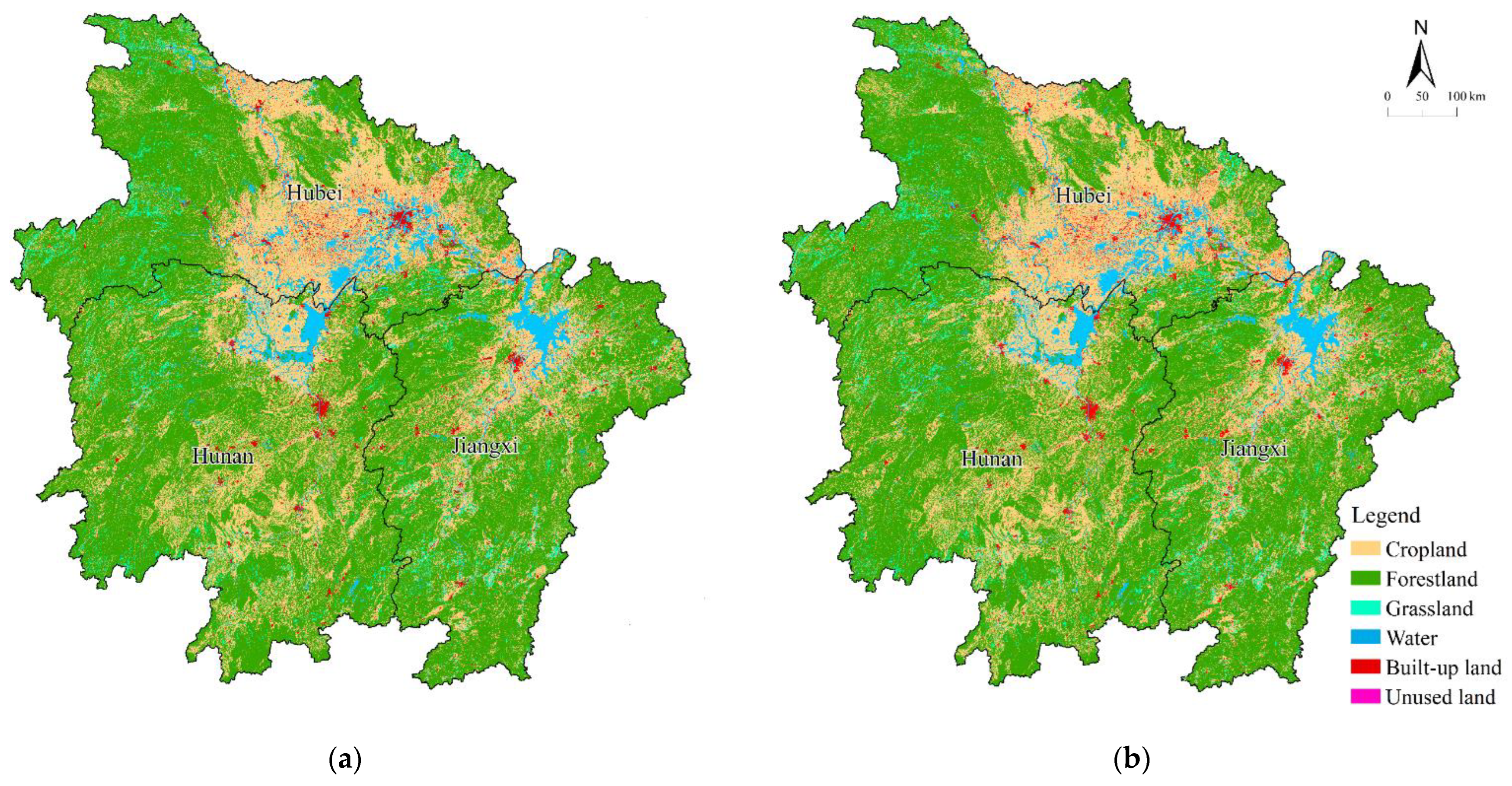
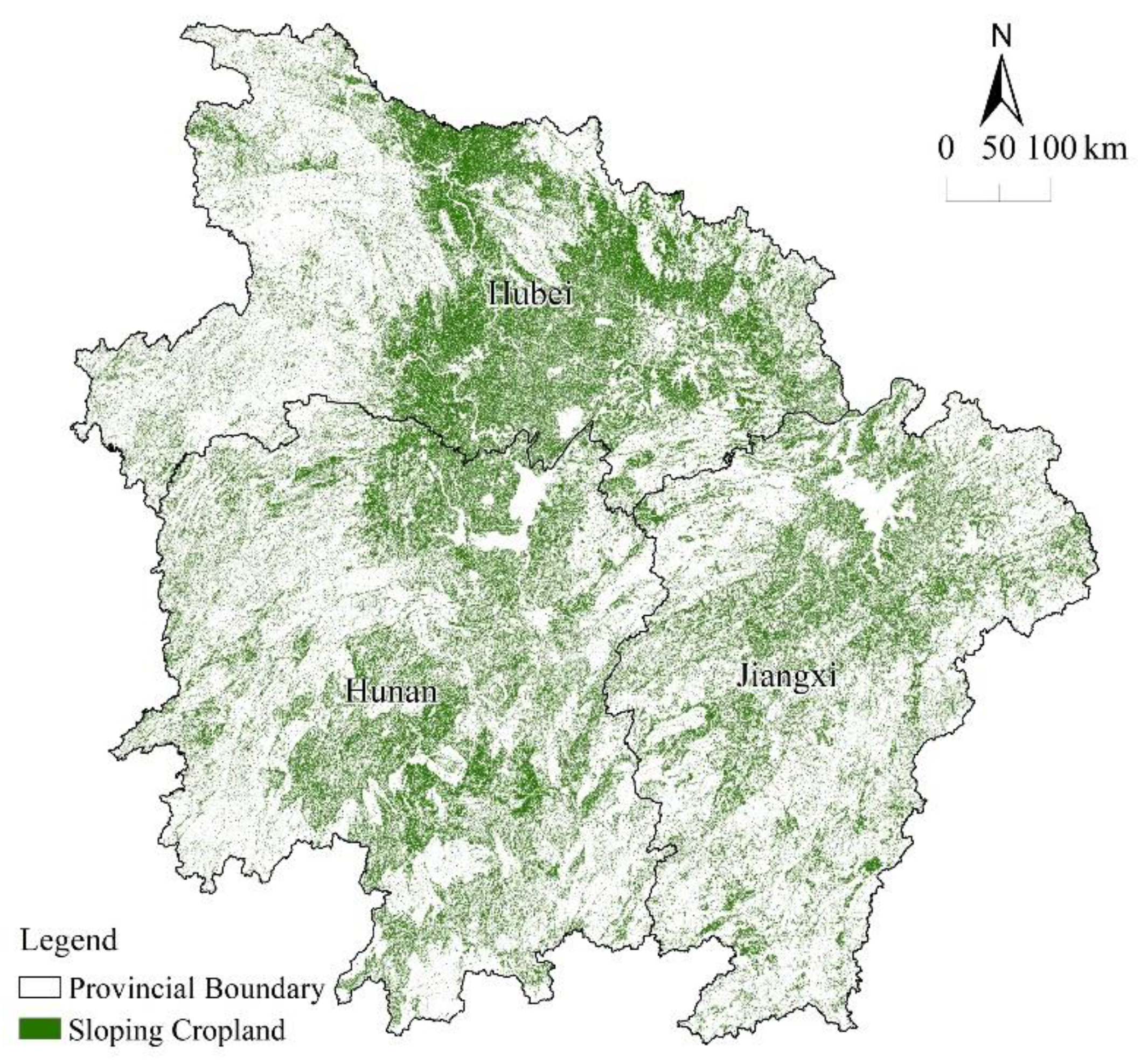


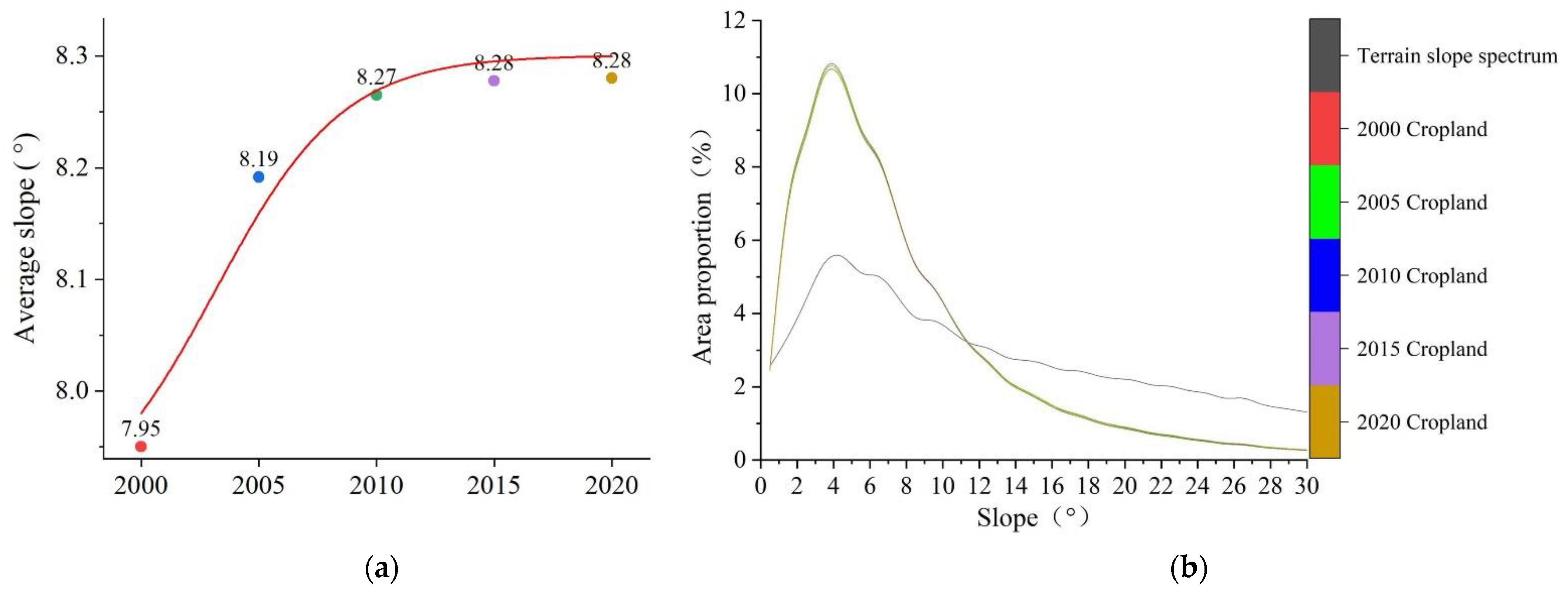

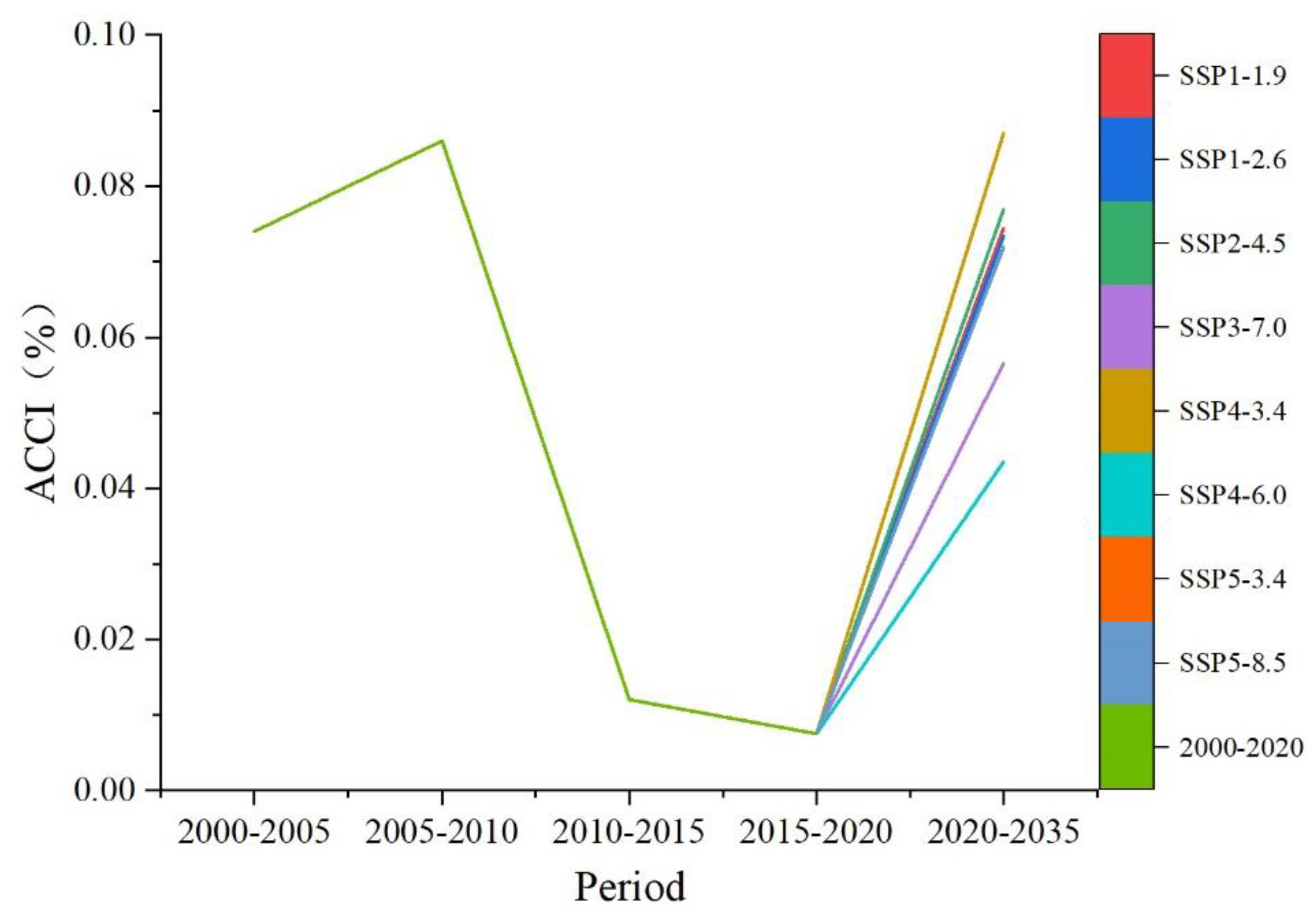
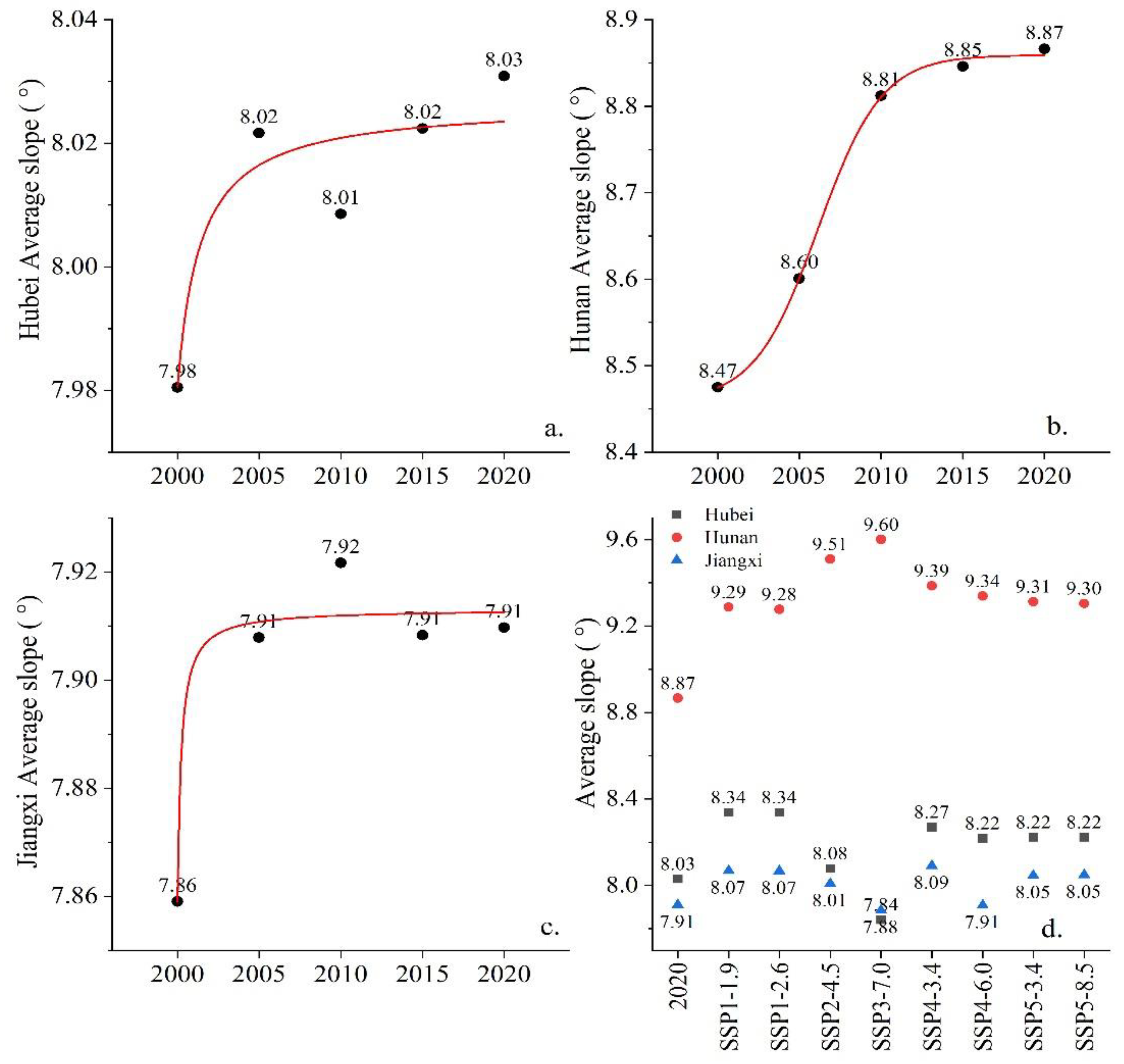


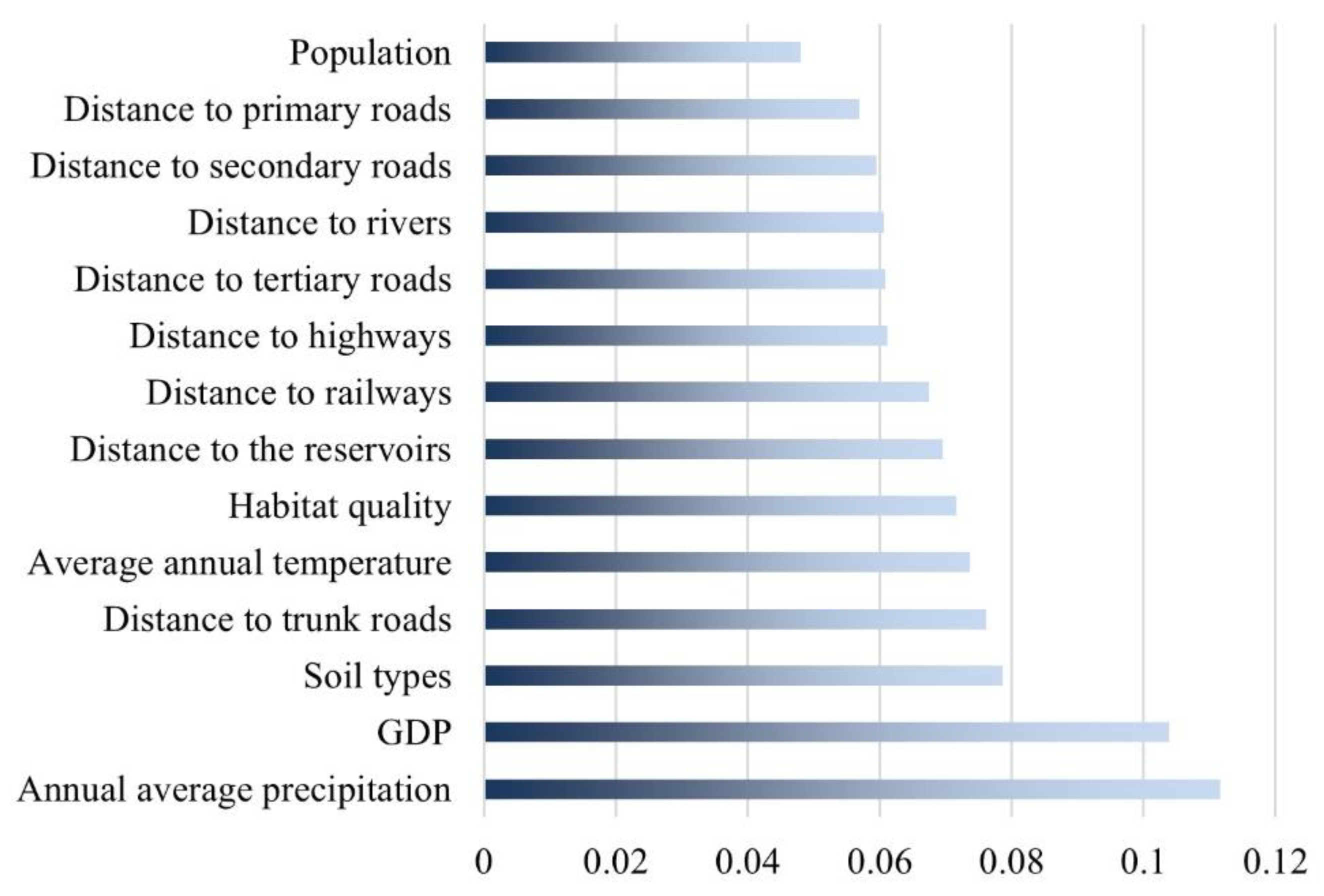

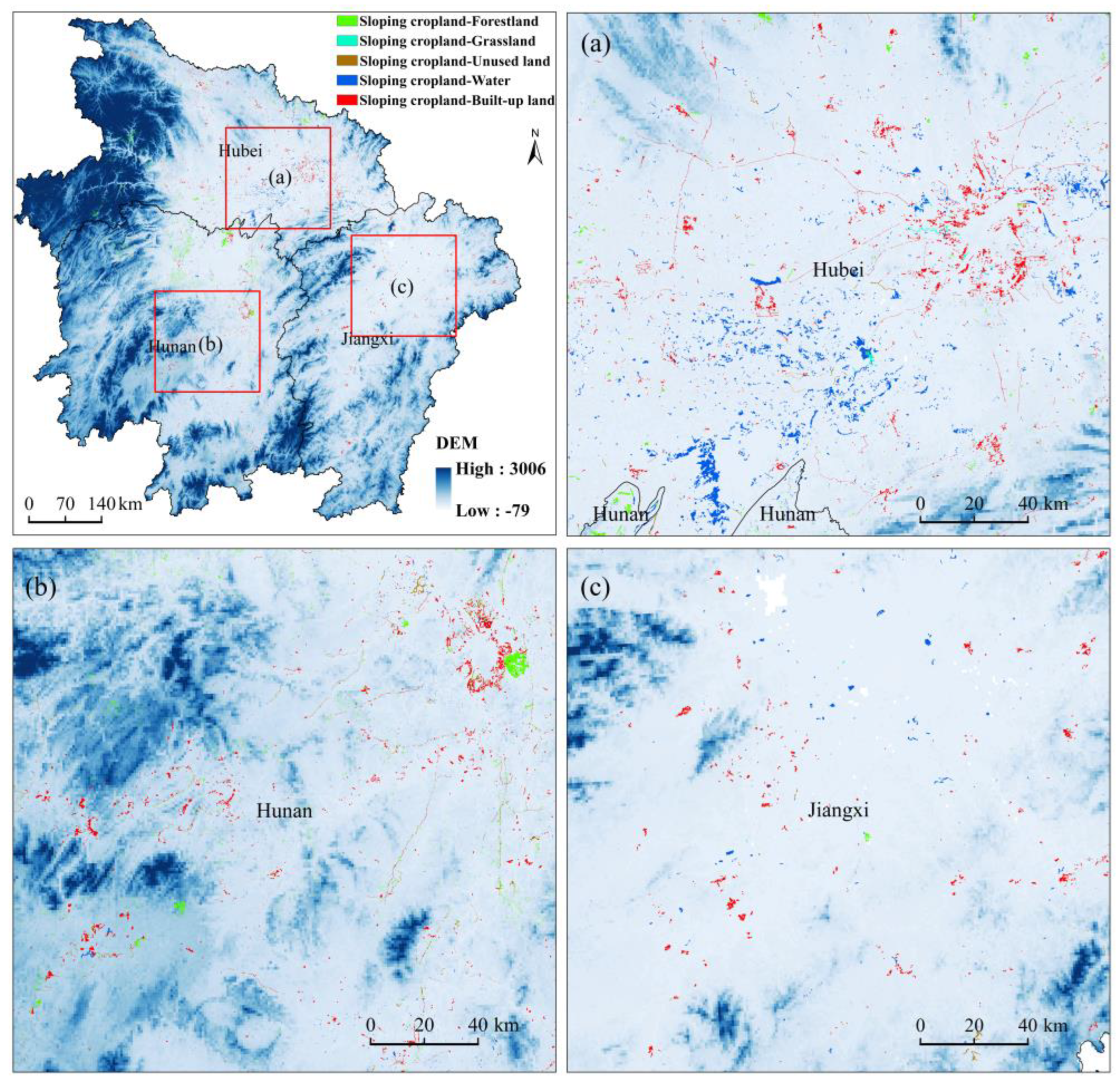
| Data Type | Data | Spatial Resolution | Data Resource |
|---|---|---|---|
| Land-use data | Land-use data of Hubei, Hunan, and Jiangxi Provinces in 2000, 2005, 2010, 2015, and 2020 | 30 m | Resource and Environment Science and Data Center of Chinese Academy of Sciences [online]. Available from: http://www.resdc.cn/Datalist1.aspx?FieldTyepID=1,3 (Accessed: 20 December 2021) |
| Environmental data | Soil type | 1 km | National Tibetan Plateau Data Center [online]. Available from: https://data.tpdc.ac.cn/zh-hans/data/611f7d50-b419-4d14-b4dd-4a944b141175/ (Accessed: 15 December 2021) |
| Habitat quality | See reference [1]. | ||
| Average annual temperature | 0.5° | WorldClim 2.1 [online]. Available from: https://www.worldclim.org/data/index.html (Accessed: 17 December 2021) | |
| Average annual precipitation | |||
| Socio-economic data | GDP | 1 km | Resource and Environment Science and Data Center of Chinese Academy of Sciences [online]. Available from: https://www.resdc.cn/data.aspx?DATAID=354 (Accessed: 17 December 2021) |
| Population | |||
| Roads and railways | Vector | OpenStreetMap [online]. Available from: https://www.openstreetmap.org/#map=5/38.007/-95.844 (Accessed: 18 December 2021) | |
| Reservoirs and rivers | Vector | National Catalogue Service for Geographic Information [online]. Available from: https://www.webmap.cn/main.do?method=index (Accessed: 20 December 2021) |
| Scenario | Description |
|---|---|
| SSP1-1.9 | The SSP1 scheme (sustainable path) is a sustainable development scheme emphasizing eco-friendly development. SSP1-1.9 describes an environmentally conscious world with the goal of limiting the environmental impact on biodiversity loss and food consumption. |
| SSP1-2.6 | From the perspective of land use, an important policy under this scenario is to increase bioenergy use and to combine carbon-capture and storage technologies to avoid deforestation policies to reduce indiscriminate logging. “Ecological protection” scenario. |
| SSP2-4.5 | SSP2 represents an intermediate path, with global and national institutions committed to achieving the sustainable development goals under the scheme; however, progress has been slow. SSP2-4.5 is a low-stability scenario that represents a scenario for sustaining current socio-economic, scientific, and technological development trends. “Development as usual” scenario. |
| SSP3-7.0 | Each country under the SSP3 scheme (regional competitive path) strives to develop on the basis of achieving energy and food-security goals. The SSP3-7.0 scenario has a radiated forcing levels close to 7.0 W/m2, resulting in a significant expansion of crop land and pasture land around the world, leading to large-scale deforestation. |
| SSP4-3.4 | SSP4 represents an unbalanced path, with more strict climate policies, which will lead to higher carbon prices. The increase in carbon prices will have a significant impact on energy and land use, with the use of a large amount of land for the production of biological energy, which will lead to a substantial increase in cropland. |
| SSP4-6.0 | SSP4-6.0 adopts a mild climate policy in which global cropland and pastures expand moderately, and a mild climate policy encourages afforestation in high- and middle-income areas with strong environmental policies. |
| SSP5-3.4 | SSP5 represents a development path for high fossil-fuel consumption. Under the SSP5-RCP3.4 scenario, there will be more cropland expansion around the world due to the large-scale deployment of second-generation bioenergy crops after 2040. |
| SSP5-8.5 | Global fossil fuel is overused under the SSP5-RCP8.5 scenario, with global food demand doubling in this century and greenhouse gas emissions tripling. Due to the rapid growth of food and feed demand, cropland extensively expands into pasture and woodland. “Economic growth” scenario. |
Disclaimer/Publisher’s Note: The statements, opinions and data contained in all publications are solely those of the individual author(s) and contributor(s) and not of MDPI and/or the editor(s). MDPI and/or the editor(s) disclaim responsibility for any injury to people or property resulting from any ideas, methods, instructions or products referred to in the content. |
© 2022 by the authors. Licensee MDPI, Basel, Switzerland. This article is an open access article distributed under the terms and conditions of the Creative Commons Attribution (CC BY) license (https://creativecommons.org/licenses/by/4.0/).
Share and Cite
Yao, X.; Luo, T.; Xu, Y.; Chen, W.; Zeng, J. Prediction of Spatiotemporal Changes in Sloping Cropland in the Middle Reaches of the Yangtze River Region under Different Scenarios. Int. J. Environ. Res. Public Health 2023, 20, 182. https://doi.org/10.3390/ijerph20010182
Yao X, Luo T, Xu Y, Chen W, Zeng J. Prediction of Spatiotemporal Changes in Sloping Cropland in the Middle Reaches of the Yangtze River Region under Different Scenarios. International Journal of Environmental Research and Public Health. 2023; 20(1):182. https://doi.org/10.3390/ijerph20010182
Chicago/Turabian StyleYao, Xiaowei, Ting Luo, Yingjun Xu, Wanxu Chen, and Jie Zeng. 2023. "Prediction of Spatiotemporal Changes in Sloping Cropland in the Middle Reaches of the Yangtze River Region under Different Scenarios" International Journal of Environmental Research and Public Health 20, no. 1: 182. https://doi.org/10.3390/ijerph20010182





